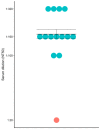Cytokine Storm Combined with Humoral Immune Response Defect in Fatal Hemorrhagic Fever with Renal Syndrome Case, Tatarstan, Russia
- PMID: 31269734
- PMCID: PMC6669480
- DOI: 10.3390/v11070601
Cytokine Storm Combined with Humoral Immune Response Defect in Fatal Hemorrhagic Fever with Renal Syndrome Case, Tatarstan, Russia
Abstract
Hemorrhagic fever with renal syndrome (HFRS) is endemic in Tatarstan, where thousands of cases are registered annually. Puumalaorthohantavirus is commonly detected in human case samples as well as in captured bank voles, the rodent hosts. The pathogenesis of HFRS is still not well described, although the cytokine storm hypothesis is largely accepted. In this study, we present a comprehensive analysis of a fatal HFRS case compared with twenty four non-fatal cases where activation of the humoral and cellular immune responses, pro-inflammatory cytokines and disturbed blood coagulation were detected using immunological, histological, genetic and clinical approaches. Multiple organ failure combined with disseminated intravascular coagulation syndrome and acute renal failure was the cause of death. Decreased Interleukin (IL)-7 and increased IL-18, chemokine (C-C motif) ligand (CCL)-5, stem cell growth factor (SCGF)-b and tumor necrosis factor-beta (TNF-β) serum levels were found, supporting the cytokine storm hypothesis of hantavirus pathogenesis.
Keywords: CCL5; HFRS; IL-18; Puumala orthohantavirus; SCGF-b; TNF-β; cytokine; fatal case.
Conflict of interest statement
The authors declare no conflict of interest
Figures





Similar articles
-
Characterization of Biomarker Levels in Crimean-Congo Hemorrhagic Fever and Hantavirus Fever with Renal Syndrome.Viruses. 2019 Jul 26;11(8):686. doi: 10.3390/v11080686. Viruses. 2019. PMID: 31357521 Free PMC article.
-
Hemorrhagic fever with renal syndrome caused by 2 lineages of Dobrava hantavirus, Russia.Emerg Infect Dis. 2008 Apr;14(4):617-25. doi: 10.3201/eid1404.071310. Emerg Infect Dis. 2008. PMID: 18394280 Free PMC article.
-
Serum TNF-α, sTNFR1, IL-6, IL-8 and IL-10 levels in hemorrhagic fever with renal syndrome.Virus Res. 2013 Jul;175(1):91-4. doi: 10.1016/j.virusres.2013.03.020. Epub 2013 Apr 17. Virus Res. 2013. PMID: 23603136
-
Severity Biomarkers in Puumala Hantavirus Infection.Viruses. 2021 Dec 28;14(1):45. doi: 10.3390/v14010045. Viruses. 2021. PMID: 35062248 Free PMC article. Review.
-
[Immunopathogenesis of hemorrhagic fever with renal syndrome and hantavirus pulmonary syndrome].Acta Med Croatica. 2003;57(5):407-14. Acta Med Croatica. 2003. PMID: 15011469 Review. Croatian.
Cited by
-
LncRNA NEAT1 Potentiates SREBP2 Activity to Promote Inflammatory Macrophage Activation and Limit Hantaan Virus Propagation.Front Microbiol. 2022 Apr 13;13:849020. doi: 10.3389/fmicb.2022.849020. eCollection 2022. Front Microbiol. 2022. PMID: 35495674 Free PMC article.
-
A Comprehensive Analysis Exploring the Vital Role of the Systemic Immune-Inflammatory Index Upon Admission in Severe Hemorrhagic Fever with Renal Syndrome.Int J Gen Med. 2024 Oct 23;17:4857-4866. doi: 10.2147/IJGM.S480204. eCollection 2024. Int J Gen Med. 2024. PMID: 39465187 Free PMC article.
-
Rosuvastatin as a Supplemental Treatment for the Clinical Symptoms of Nephropathia Epidemica: A Pilot Clinical Study.Viruses. 2024 Feb 17;16(2):306. doi: 10.3390/v16020306. Viruses. 2024. PMID: 38400081 Free PMC article.
-
Characterization of Biomarker Levels in Crimean-Congo Hemorrhagic Fever and Hantavirus Fever with Renal Syndrome.Viruses. 2019 Jul 26;11(8):686. doi: 10.3390/v11080686. Viruses. 2019. PMID: 31357521 Free PMC article.
-
Immunogenic Properties of MVs Containing Structural Hantaviral Proteins: An Original Study.Pharmaceutics. 2022 Jan 1;14(1):93. doi: 10.3390/pharmaceutics14010093. Pharmaceutics. 2022. PMID: 35056989 Free PMC article.
References
-
- Khismatullina N.A., Karimov M.M., Khaertynov K.S., Shuralev E.A., Morzunov S.P., Khaertynova I.M., Ivanov A.A., Milova I.V., Khakimzyanova M.B., Sayfullina G., et al. Epidemiological dynamics of nephropathia epidemica in the Republic of Tatarstan, Russia, during the period of 1997–2013. Epidemiol. Infect. 2016;144:618–626. doi: 10.1017/S0950268815001454. - DOI - PubMed
-
- Kabwe E., Davidyuk N.Y., Morzunov S.P., Shakirova V.G., Anokhin V.A., Isaeva G.S., Ismagilova R.K., Khaiboullina S.F., Rizvanov A.A. Genetic Characterization of Small (s)-Segment Genome Puumala Virus Strain Kazan. BioNanoScience. 2017;7:316–319. doi: 10.1007/s12668-016-0338-2. - DOI
Publication types
MeSH terms
Substances
LinkOut - more resources
Full Text Sources
Research Materials
Miscellaneous

